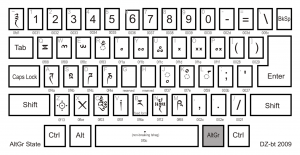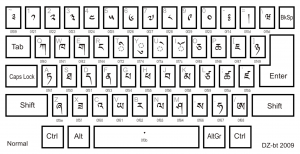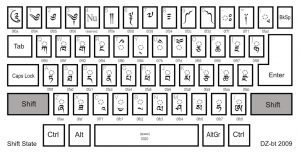Difference between revisions of "Dzongkha/Keyboard"
(→Justification) |
(→Existing Resources) |
||
| Line 9: | Line 9: | ||
[[File:Dzolvl2.png|thumb|none|The modern standard Dzongkha keyboard layout '''Level 2''']] | [[File:Dzolvl2.png|thumb|none|The modern standard Dzongkha keyboard layout '''Level 2''']] | ||
<br /> | <br /> | ||
| + | |||
| + | The first level has characters arranged alphabetically with an awkward placement of vowels right at the middle of the top row. | ||
| + | The second level has the diacritic version of the alphbets. Since it is a frequent attachment of multiple diacritics on a single character (ranging from 1 to 4 attachments), pressing and releasing the shift key is found to be a tiring and inefficient process by most users. | ||
== Optimized Keyboard Layout == | == Optimized Keyboard Layout == | ||
Revision as of 15:25, 27 February 2021
Contents
Existing Resources
Dzongkha Keyboard Layout (2009) was jointly designed by the Dzongkha Development Commission (DDC) and the Department of Information Technology (DIT). It is available on platforms such as Windows, Linux, and macOS. Click here to find instructions to download and install the official keyboard. It is not included in the standard OS but for iOS or Android on a phone or tablet, you can download the "Dzongkha Keyboard (DDC)" app to access the layout. The layout is standardized across platforms. We have attached all four levels of the layout below.
The first level has characters arranged alphabetically with an awkward placement of vowels right at the middle of the top row. The second level has the diacritic version of the alphbets. Since it is a frequent attachment of multiple diacritics on a single character (ranging from 1 to 4 attachments), pressing and releasing the shift key is found to be a tiring and inefficient process by most users.
Optimized Keyboard Layout
Justification
Since characters with multiple diacritics are very common, most users find the constant use of shift tiring and inefficient.
(i guess mention here how we tried to solve this problem but the challenges we faced that made it not possible to solve atm)
The official keyboard also borrows a lot of punctuation marks and symbols from the original Tibetan language but since they are not used often (or at all) in the ordinary Dzongkha language and are reserved mostly (and almost exclusively) for religious Sanskrit texts, we are omitting it from our current prototype keyboard version.
We were thereby, able to reduce the four levels of keys to two levels.
The current goal is to optimize the keyboard by rearranging the keys to match the <model nicolas referred to?>. We documented the character frequency from a corpus of Dzongkha folktales, poems, and news.
(should we include a section for future improvement? or potential areas to work on?)



